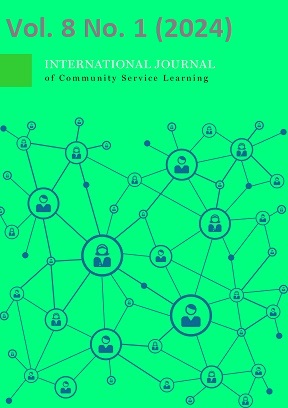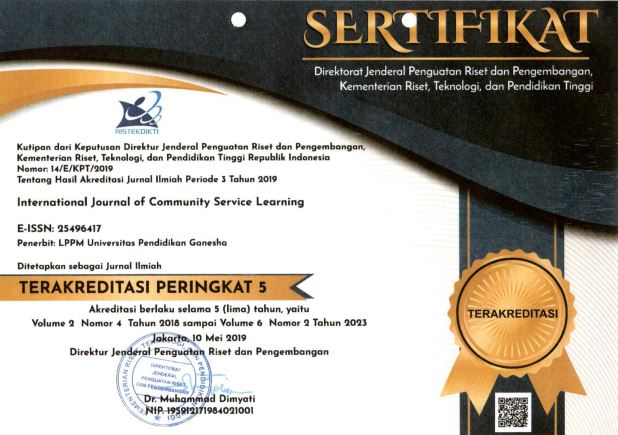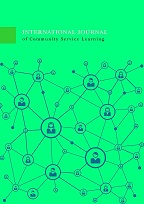Making Unique Handicrafts from Shells in Lake Bird's Nest Village
DOI:
https://doi.org/10.23887/ijcsl.v8i1.74246Keywords:
Handicraft, Shells, WasteAbstract
Making unique handicrafts using shells in Sarang Burung Danau Village aims to process marine waste which can be used as a creative medium for PKK mothers, increasing creativity, soft skills and an entrepreneurial spirit from an early age. This activity is focused on making unique craft items using shells as the main material, stimulating creativity and economic empowerment in the village. This initiative involves collaboration between students from various universities involved in KKN Kebangsaan 2023 activities and the local community, emphasizing the exchange of knowledge, skills and cultural experiences. The method for this service activity is to conduct a workshop which directs the training participants to practice directly making handicrafts by following the work steps. Through workshops and hands-on activities, participants explore innovative craft-making techniques while using natural resources responsibly. With this type of qualitative research, the results of this activity are a source of pride for the community, creating economic opportunities and preserving traditional skills. The products produced include pencil cases, wall hangings, mirror frames and miniature birds. The aim of this research is to encourage environmental awareness by emphasizing the sustainable use of shellfish resources. The implication of this research is that it can encourage the use of local resources, in this case shellfish, more effectively. This can help reduce pressure on the environment and promote sustainable practices in the use of natural resources.
References
Abubakar, S., Kadir, M., Serosero, R., Subur, R., Widiyanti, S., Susanto, A., Rina, & Asrining, R. P. (2021). No Title. Utilization of Shellfish Waste for Coastal Community Handicraft Products.Journal of Master of Science Education Service. https://doi.org/10.29303/jpmpi.v4i4.1010.
Al Islamiyah, S., Azis, R., & Engelen, A. (2021). Utilizing this waste is one type of skill that the community has.Servant. Scientific Journal, 7(1). https://doi.org/10.21107/pangabdhi.v7i1.9883.
Astiani, D., Ekamawanti, H. A., Widiastuti, T., Ekyastuti, W., & Roslinda, E. (2022). Seminar Nasional Pengabdian dan CSR Ke-2 Fakultas Pertanian Universitas Sebelas Maret , Surakarta Peningkatan Kreativitas Masyarakat Melalui Pelatihan Kerajinan Tangan Berbahan Dasar Kulit Kerang di Kelurahan Setapuk Besar Seminar Nasional Pengabdian dan . 185–191.
Fitri, N., & Rusmini. (2017). Characterization of Chitosan from Shell Waste (Placuna Placenta).UNESA. Journal of Chemistry, 109–113. https://ejournal.unesa.ac.id/index.php/unesa-journal-of-chemistry/article/view/17624/16056.
Hardjanto, K. (2020). Utilization of Shellfish Waste as a Source of Household Economy: Case Study at Sabila Craft. Magelang City.Marina Scientific Bulletin Socioeconomic Maritime Affairs and Fisheries, 125(ttps://doi.org/10.15578/marina.v6i2.8644). DOI: https://doi.org/10.15578/marina.v6i2.8644
Ishchenko-Padukova, O., & Movchan, I. (2022). Creative entrepreneurship in this area: development trends and regulatory problems in the knowledge economy.International. Journal of Economics and Education, 1(3), 6–14 10 3390 142316010. https://doi.org/10.3390/su142316010.
Islamiyah, S. Al, Azis, R., & Engelen, A. (2021). Pemanfaatan Limbah Cangkang Kerang Menjadi Cinderamata. Jurnal Ilmiah Pangabdhi, 7(1), 41–43. https://doi.org/10.21107/pangabdhi.v7i1.9883. DOI: https://doi.org/10.21107/pangabdhi.v7i1.9883
Kurnia, A., & Ode, L. (2019). Kelayakan Usaha Kerajinan Tangan Dari Kulit Kerang. 14(2), 86–90. DOI: https://doi.org/10.14710/ijfst.14.2.86-90
Lazzaro, E. (2021). Linking the creative economy with university entrepreneurship: A spillover approach.Sustainability (Vol. 13, Issue 3, pp. 1–12 10 3390 13031078). https://doi.org/10.3390/su13031078. DOI: https://doi.org/10.3390/su13031078
Margareth, H. (2017). Kerajinan Kerang. Экономика Региона, 32.
Muhammad Taswin Munier, Ishak, E., Bahtiar, Muhammad Fajar Purnama, Yustika Intan Permatahati, Latifa Fekri, & Irwan Junaidi Effendy. (2022). Pemanfaatan Limbah Cangkang Kerang Guna Meningkatkan Keterampilan Istri Nelayan di Kelurahan Lapulu. Jurnal Pengabdian Meambo, 1(2), 128–135. https://doi.org/10.56742/jpm.v1i2.21. DOI: https://doi.org/10.56742/jpm.v1i2.21
Musapana, S., & Amalia, I. R. (2020a). Kerajinan Limbah Cangkang Kerang Sebagai Alternatif Pembuatan Bros Ramah Lingkungan Tambakrejo Semarang. ABDI: Jurnal Pengabdian Dan Pemberdayaan Masyarakat, 2(1), 58–66. https://doi.org/10.24036/abdi.v2i1.54.
Musapana, S., & Amalia, I. R. (2020b). Shellfish Waste Crafts as an Environmentally Friendly Alternative for Making Brooches in Tambakrejo Semarang.ABDI. Journal of Community Service and Empowerment, 58–65. .https://doi.org/10.24036/abdi.v2i1.54. DOI: https://doi.org/10.24036/abdi.v2i1.54
Nanik, H., Hendra, S., & Minullah. (2018). Economic Analysis of Sea Shells as a Basic Material for Making Shell Souvenirs.GATR. Business and Economics Journal Review, 3(4), 87–91. https://doi.org/10.35609/jber.2018.3.4(2) DOI: https://doi.org/10.35609/jber.2018.3.4(2)
Naylor, T. D., & Florida, R. (2003). The rise of the creative class: And how it is changing work, leisure and everyday life.Canadian Public Policy /. Analysis de Politiques, 29(3), 378 10 2307 3552294. https://doi.org/10.2307/3552294. DOI: https://doi.org/10.2307/3552294
Nisa, M., P., N., Umma, N. A., Lalimuga, Y. I., Maghfirah, A., & Alpriani, S. (2023). No Title. https://journal.universitaspahlawan.ac.id/index.php/cdj/article/view/13897.
Nor, J. R. (2017). Development of Simping Shell Craft Art Product Design.Productum. Journal of Product Design (Product Knowledge and Design. https://doi.org/10.24821/productum.v3i1.1736. DOI: https://doi.org/10.24821/productum.v3i1.1736
Nurhayani, U., Azis, A. C., Nasution, A. H., Herliani, R., & Purba, E. L. (2019). Introduction to Product Innovation and Marketing Strategy in the Souvenir Craft Industry Based on Shell Waste in Tanjung Balai City.Journal of. Research and Community Service, 2(2), 226 10 24114 2 2 13154. https://doi.org/10.24114/jcrs.v2i2.13154. DOI: https://doi.org/10.24114/jcrs.v2i2.13154
Pratt, A. C. (2022). Towards circular governance in culture and the creative economy: Lessons from the circular economy and the environment.Cities. Culture and Society. .https://doi.org/10.1016/j.ccs.2022.100450. DOI: https://doi.org/10.1016/j.ccs.2022.100450
Rahmadina, R., & Tambunan, E. P. S. (2017). Pemanfaatan Limbah Cangkang Telur, Kulit Bawang Dan Daun Kering Melalui Proses Sains Dan Teknologi Sebagai Alternatif Penghasil Produk Yang Ramah Lingkungan. KLOROFIL: Jurnal Ilmu Biologi Dan Terapan, 1(1), 48. https://doi.org/10.30821/kfl:jibt.v1i1.1575. DOI: https://doi.org/10.30821/kfl:jibt.v1i1.1575
Ratnawati, & Yani, A. (2020). Training on the Use of Sea Shells for Craft Goods for Coastal Communities in Bontang City.BERDAYA. Journal of Education and Community Service, 16(ttps://dx.doi.org/10.36407/berdaya.v2i1.168).
Rodríguez-Insuasti, H. M.-B., N., S.-R., & O., Y.-M. M.-G. (2022). Creative Economy: World Research in Business. Management and Accounting.Sustainability (Switzerland, 14(23). https://doi.org/10.3390/su142316010. DOI: https://doi.org/10.3390/su142316010
Salim, A., Kadir, M. A., Serosero, R. H., Subur, R., Widiyanti, S. E., Susanto, A. N., Rina, & P, R. T. A. (2021). Pemanfaatan Limbah Cangkang Kerang Untuk Produk Kerajinan Tangan Masyarakat Pesisir. Jurnal Pengabdian Magister Pendidikan IPA, 4(4), 42–49. https://doi.org/10.29303/jpmpi.v3i2.1010. DOI: https://doi.org/10.29303/jpmpi.v4i4.1010
Sangeta, M. (2017). Goa Shell Arts and Crafts (M. Sangeta & G. S. Shells (eds.); pp. 185–217). https://doi.org/10.1007/978-3-319-55099-2_4. DOI: https://doi.org/10.1007/978-3-319-55099-2_4
Seraceddin Levend Zorluoğlu. (2012). Pembelajaran Keterampilan Tangan.
Simard, N. S., Militz, T. A., & Southgate, J. K. (2008). Shell-based handicrafts in Papua New Guinea: Challenges and opportunities for livelihood development.Peloncat. https://doi.org/10.1007/s13280-018-1078-z. DOI: https://doi.org/10.1007/s13280-018-1078-z
Supriadi, N., & Z, W. J. (2021). Community Empowerment Through Seashell Craft Design Training to Improve the Household Economy.Panrita Abddi-Journal of. Community Service, 5(1), 41–50. https://journal.unhas.ac.id/index.php/panritaabdi/article/view/8811.
Syariah, K. B., & Ilmu, G. (2016). Analisis Kelayakan Kerajinan Tangan Dari Kulit Kerang. september 2016, 1–6.
Thobias, E. T. (2017). The Influence of Social Capital on Entrepreneurial Behavior (A study of micro, small and medium entrepreneurs in Kabaruan District.
Topić Popović, N., Lorencin, V., Strunjak-Perović, I., & Čož-Rakovac, R. (2023). Management and Utilization of Shellfish Waste: Reducing Organic Pollution and Increasing Sustainability.Applied Sciences (Switzerland. MDPI. https://doi.org/10.3390/app13010623. DOI: https://doi.org/10.3390/app13010623
Variani, V. I., Firihu, M. Z., Nurjannah, I., Fahmiati, T., A., L., A., S., & Ismail, D. (2023). novation Utilizing Clam Shell Waste to Make Souvenirs to Support the Bokori Island Tourist Destination.Meambo Community. Service Journal, 2(1), 19–26. DOI: https://doi.org/10.56742/jpm.v2i1.53
Downloads
Published
How to Cite
Issue
Section
License
Copyright (c) 2024 fitriah

This work is licensed under a Creative Commons Attribution-ShareAlike 4.0 International License.

International Journal of Comunnity Service Learning is licensed under a Creative Commons Attribution-ShareAlike 4.0 International License.













